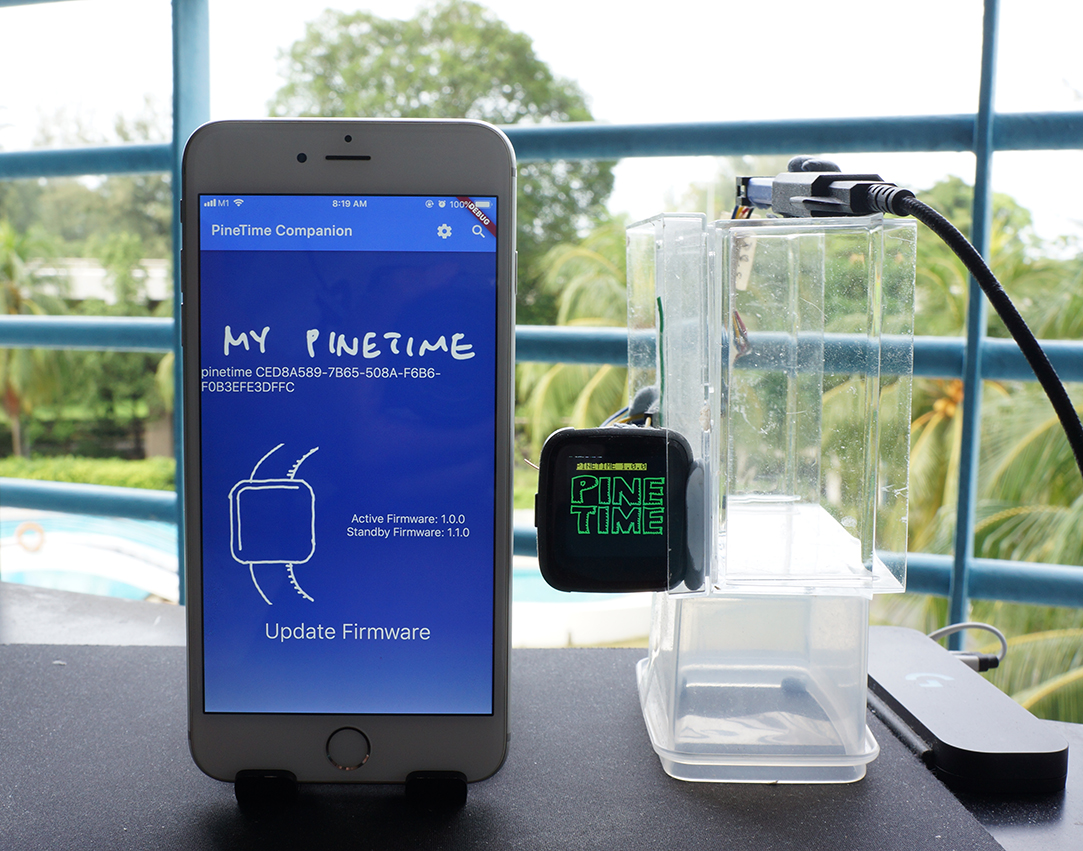

Work-in-progress PineTime Companion App on iPhone, converted from Go to Flutter and Dart
📝 9 Jul 2020
NOTE: THIS ARTICLE IS UNFINISHED
We're now building with Flutter the open source Android and iOS Companion App for PineTime Smart Watch: For updating firmware, syncing date/time, pushing mobile notifications, controlling our smart home gadgets, ... and so much more!
There's a problem: The code to do all this is available in Go... But Flutter runs on another language: Dart!
Today we shall experiment with converting Go code to Dart automatically. The conversion may not be perfect, but it will be very helpful for building the PineTime Companion App!
Read on to learn how this Go code: nmxact/nmp/image.go
// Convert From Go...
// Go Struct
type ImageUploadReq struct {
NmpBase `codec:"-"`
ImageNum uint8 `codec:"image"`
Off uint32 `codec:"off"`
Len uint32 `codec:"len,omitempty"`
DataSha []byte `codec:"sha,omitempty"`
Upgrade bool `codec:"upgrade,omitempty"`
Data []byte `codec:"data"`
}
// Go Function
func NewImageUploadReq() *ImageUploadReq {
r := &ImageUploadReq{}
fillNmpReq(r, NMP_OP_WRITE, NMP_GROUP_IMAGE, NMP_ID_IMAGE_UPLOAD)
return r
}
Was automatically converted to this Dart code: dart/nmp/image.dart
// Converted To Dart...
// Converted Dart Class
class ImageUploadReq
with NmpBase // Get and set SMP Message Header
implements NmpReq // SMP Request Message
{
int ImageNum; // image: uint8
int Off; // off: uint32
int Len; // len: uint32
typed.Uint8Buffer DataSha; // sha: []byte
bool Upgrade; // upgrade: bool
typed.Uint8Buffer Data; // data: []byte
NmpMsg Msg() { return MsgFromReq(this); }
/// Encode the SMP Request fields to CBOR
void Encode(cbor.MapBuilder builder) {
builder.writeString("image");
builder.writeInt(ImageNum); // uint8
// ...Omitted...
builder.writeString("data");
builder.writeArray(Data); // []byte
}
}
// Converted Dart Function
ImageUploadReq NewImageUploadReq() {
var r = ImageUploadReq();
fillNmpReq(r, NMP_OP_WRITE, NMP_GROUP_IMAGE, NMP_ID_IMAGE_UPLOAD);
return r;
}
Earlier we attempted a manual code conversion from Go to Dart...
"Convert Go to Flutter and Dart for PineTime Companion App"
But it became really tedious and mechanical...
Add a Semicolon (;) to every line
Flip the Names and Types, so this Go code...
// In Go...
Len uint32
Becomes this code in Dart...
// In Dart...
int Len;
Flip all Functions from this...
// In Go...
func NewImageUploadReq() *ImageUploadReq { ...
To this...
// In Dart...
ImageUploadReq NewImageUploadReq() { ...
It's easy to encode Go Structs into CBOR...
// In Go...
type ImageUploadReq struct {
// Struct Field "Len" will be encoded as key "len" in CBOR
Len uint32 `codec:"len,omitempty"`
But encoding a Dart Class into CBOR is cumbersome and error-prone...
// In Dart...
class ImageUploadReq {
int Len;
...
void Encode(cbor.MapBuilder builder) {
// Class Field "Len" will be encoded as key "len" in CBOR
builder.writeString("len");
builder.writeInt(Len);
Surely a computer can do this tedious and mechanical conversion from Go to Dart?
Yes it can, with an Abstract Syntax Tree!
Have you ever wondered... Why do we speak the way we speak?
Why is this ok...
I EAT RICE
But not this?
I RICE
Because there's a structure in everything that we say...
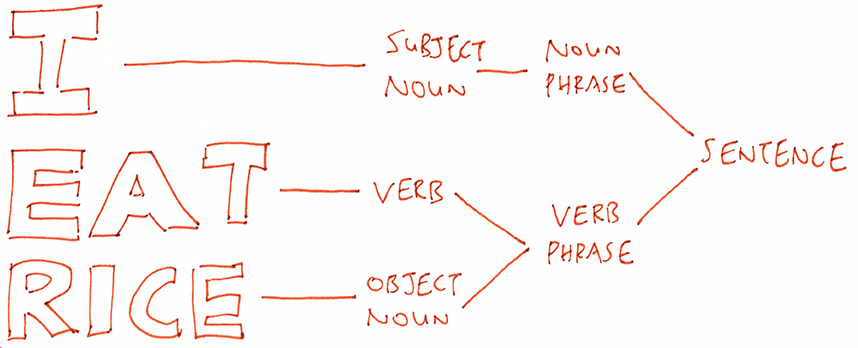
We call this tree-like structure the Syntax Tree (though it looks more like a flying broomstick)
What's a Syntax Tree good for?
A Syntax Tree is useful for translating languages. To translate I EAT RICE to Chinese, we take each chunk of the tree ("subtree") and translate each chunk to Chinese...
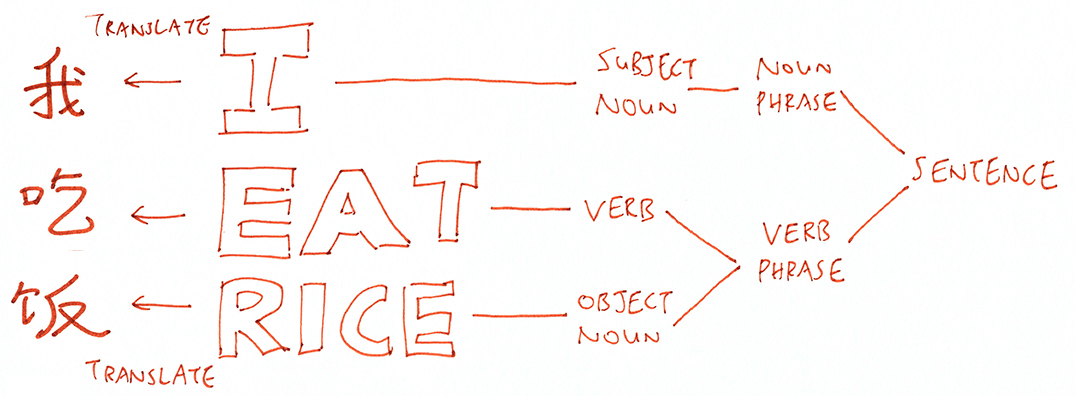
Does this work for translating Programming Languages like Go and Dart?
Yes! Our Go program may also be structured as a Syntax Tree...
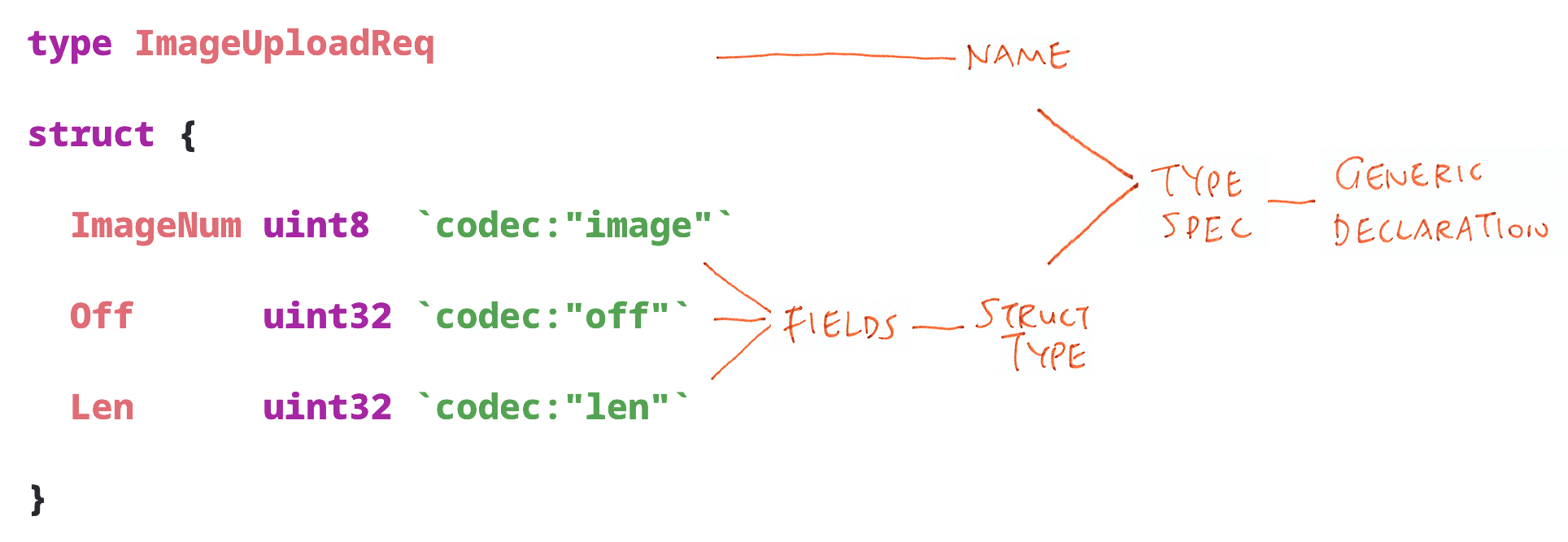
And we may translate the Syntax Tree to Dart the same way, subtree by subtree.
Why not just translate word by word?
Because the Surrounding Context matters!
If we don't look at the surrounding text, translating I EAT RICE word for word produces this hilarious result...
我吃米
Which sounds really weird because it means...
I EAT UNCOOKED RICE
(Unless we really meant to say "老鼠吃大米")
Let's find out how to generate a Syntax Tree automatically for our Go code.
Go provides the ast library for parsing Go code into an Abstract Syntax Tree.
Here's how we call ast to generate an Abstract Syntax Tree for a block of Go code: dart/convert.go
import (
"go/ast"
"go/format"
"go/parser"
"go/token"
)
// Inspect the Abstract Syntax Tree of our Go code and convert to Dart
func convertGoToDart() {
// Create the Abstract Syntax Tree by parsing the Go code in "src"
fileset := token.NewFileSet() // Positions are relative to fileset
// Change "src" to "nil" to parse the file "src.go" instead of the string
node, err := parser.ParseFile(fileset, "src.go", src, 0)
if err != nil {
panic(err)
}
...
}
src is a string that contains our Go source code (that will be converted to Dart): dart/convert.go...
// Go code to be converted to Dart. "package" is mandatory. "bt" means backtick "`"
const src = `
package main
type ImageUploadReq struct {
NmpBase ` + bt + `codec:"-"` + bt + `
ImageNum uint8 ` + bt + `codec:"image"` + bt + `
Off uint32 ` + bt + `codec:"off"` + bt + `
// ...Omitted...
}
func NewImageUploadReq() *ImageUploadReq {
r := &ImageUploadReq{}
fillNmpReq(r, NMP_OP_WRITE, NMP_GROUP_IMAGE, NMP_ID_IMAGE_UPLOAD)
return r
}
`
The ParseFile() method above parses the Go code in src and returns the Abstract Syntax Tree in node...
node, err := parser.ParseFile(fileset, "src.go", src, 0)
We'll inspect node in the next section.
Why did we call NewFileSet()?
fileset := token.NewFileSet()
This creates a FileSet object that tracks the filename, line number and column number of our Go code in the Abstract Syntax Tree.
FileSet is useful for flagging the Go code that fails with our automatic conversion.
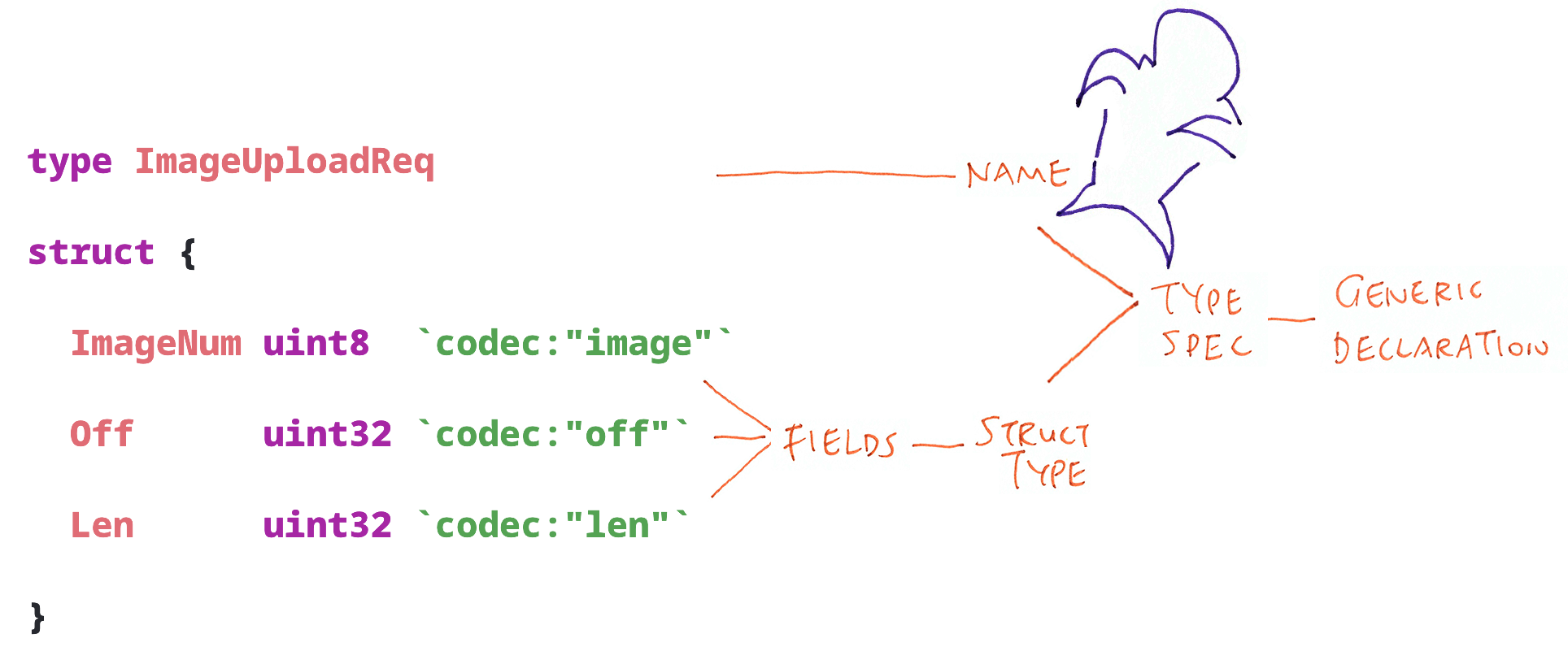
Now that we have the Abstract Syntax Tree in node, let's walk the tree!
(Caution: Never walk under a Durian Tree!)
Here's how we walk an Abstract Syntax Tree and convert each chunk of Go code in the tree: dart/convert.go
// Inspect the Abstract Syntax Tree of our Go code and convert to Dart
func convertGoToDart() {
// Omitted: Create the Abstract Syntax Tree in "node" by parsing Go code
...
// Convert all Go Struct and Function Declarations in "node"
for _, decl := range node.Decls {
// What kind of subtree is this?
switch decl := decl.(type) {
// If it's a Generic Declaration...
case *ast.GenDecl:
// Convert the Go Struct to Dart
convertStruct(fileset, decl)
// If it's a Function Declaration...
case *ast.FuncDecl:
// Convert the Go Function to Dart
convertFunction(fileset, decl)
// Not sure!
default:
// Flag the code location using the fileset
fmt.Println("*** Unknown Decl:")
ast.Print(fileset, decl)
}
}
}
Let's study the code above. Recall that node contains a Go Struct and a Go Function...
// Go Struct parsed as Generic Declaration (GenDecl)
type ImageUploadReq struct { ... }
// Go Function parsed as Function Declaration (FuncDecl)
func NewImageUploadReq() *ImageUploadReq { ... }
The ast library parses both as Declarations...
Generic Declaration (GenDecl): Declaration for a Go Struct
Function Declaration (FuncDecl): Declaration for a Go Function
Declarations are parked under the Decls property of our node.
Hence we convert Go Structs and Functions by iterating over all Decls like so...
// "Decls" contains all Go Struct and Function Declarations in "node"
for _, decl := range node.Decls { ...
Next we inspect the type of the Declaration in decl...
// What kind of subtree is this?
switch decl := decl.(type) {
// If it's a Generic Declaration...
case *ast.GenDecl:
// Convert the Go Struct to Dart
convertStruct(fileset, decl)
// If it's a Function Declaration...
case *ast.FuncDecl:
// Convert the Go Function to Dart
convertFunction(fileset, decl)
Then we call...
convertStruct() to convert a Go Struct (parsed as GenDecl)
convertFunction() to convert a Go Function (parsed as FuncDecl)
We'll see convertStruct() and convertFunction() in a while. First let's learn how Go types are converted to Dart.
Now we'll map Go Types to Dart Types, which is needed for converting Go Structs and Functions.
Go has specific numeric types like uint8 (unsigned 8-bit integer), but Dart only has a single integer type: int. Here's how we map the types...
| Go Type | Dart Type | CBOR Type |
|---|---|---|
bool | bool | Bool |
uint8 | int | Int |
uint16 | int | Int |
uint32 | int | Int |
[]byte | typed.Uint8Buffer | Array |
We use Uint8Buffer from the typed_data Dart Library to represent byte buffers (like Bluetooth messages).
What's the CBOR Type?
Our PineTime Smart Watch firmware exposes the Simple Management Protocol over Bluetooth LE. The protocol supports a rich set of commands for updating PineTime firmware, accessing the PineTime Flash filesystem, debug logs, runtime statistics, ...
The Simple Management Protocol uses CBOR to encode the Bluetooth LE messages. (Think of CBOR as a compact, binary form of JSON)
Thus each Go Type also needs to be converted as a CBOR Type. We'll be encoding CBOR messages with the cbor Dart Library.
Here is the code that converts a Go Type to Dart and CBOR: dart/convert.go
// Convert a Go type to Dart type and CBOR type
func convertType(typeName string) (string, string) {
switch typeName {
case "bool":
return "bool", "Bool"
case "uint8":
return "int", "Int"
case "uint16":
return "int", "Int"
case "uint32":
return "int", "Int"
case "[]byte":
return "typed.Uint8Buffer", "Array"
default:
return "UNKNOWN", "UNKNOWN"
}
}
For convenience, we create a DartField Struct that stores the converted types: dart/convert.go
// DartField represents a Go Struct Field converted to Dart and CBOR
type DartField struct {
Name string // e.g. "Len"
CborName string // e.g. "len"
GoType string // e.g. "uint32"
DartType string // e.g. "int"
CborType string // e.g. "Int"
}
We'll use DartField in the next section.
Now that we have the function convertType() that converts a Go Type to Dart and CBOR, let's call it to convert each field of a Go Struct: dart/convert.go
// Convert a Go Struct Field astField to Dart
func convertField(fileset *token.FileSet, astField *ast.Field) DartField {
// Create a new DartField
dartField := DartField{}
Function convertField() takes a Go Struct Field like Len...
// In Go...
type ImageUploadReq struct {
// Go Struct Field "Len" will be converted to Dart and CBOR
Len uint32 `codec:"len,omitempty"`
And returns a DartField like so...
// In Dart: When we convert the above "Len" field from Go to Dart...
type DartField struct {
Name string // Contains "Len"
CborName string // Conatins "len"
GoType string // Contains "uint32"
DartType string // Contains "int"
CborType string // Contains "Int"
}
The ast library parses each field of our Go Struct as an ast.Field...
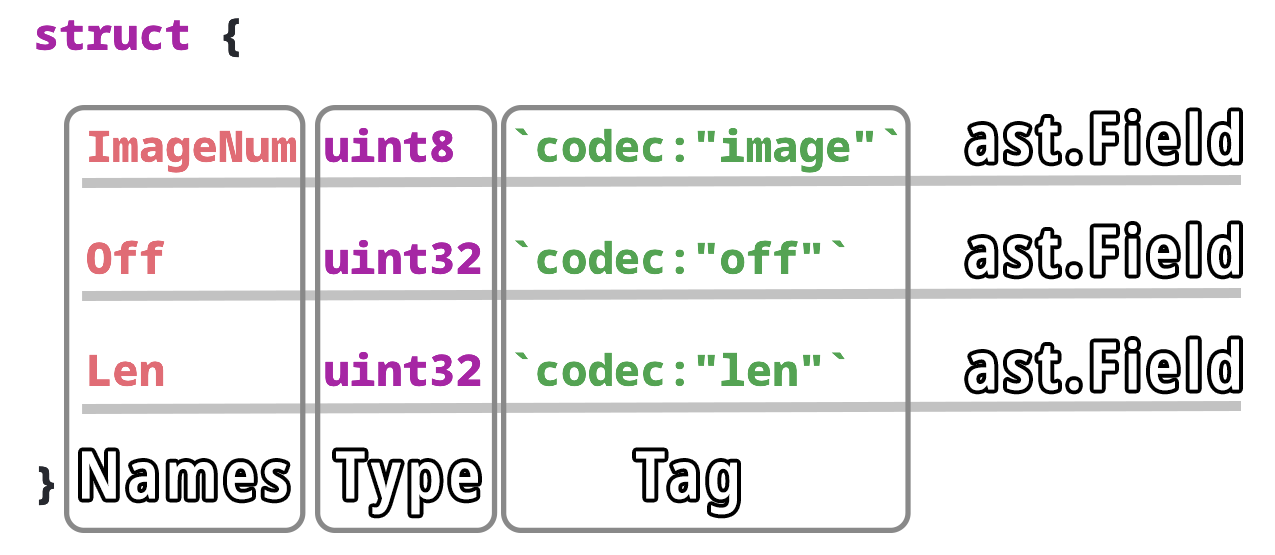
Let's convert each component of ast.Field...
Names: Name of the Struct Field
Type: Type of the Struct Field
Tag: Field Tag, which includes the CBOR Name
First step of the Field Conversion: Copy the Field Name from ast.Field.Names to DartField (if it has one): dart/convert.go
// Convert the Go Struct Field "astField" to Dart
func convertField(fileset *token.FileSet, astField *ast.Field) DartField {
...
// If this field has a name...
if len(astField.Names) > 0 {
// Set the name
dartField.Name = astField.Names[0].Name // e.g. "Len"
}
Why did we specify Names[0]?
Because each row of the Struct Declaration can have multiple names...
type Circle struct {
x, y, r float64
}
We'll assume there's only one name per row.
Next we translate the Go Type from ast.Field.Type to DartField: dart/convert.go
// Set the field type
dartField.GoType = fmt.Sprintf("%v", astField.Type) // e.g. "uint32"
This works for simple Go Types like uint32. But the code above converts array types like []byte to something weird like...
&{181 <nil> byte}
We fix this by rewriting anything that matches &{...byte} to []byte...
// Handle converted Go Type "&{181 <nil> byte}" as "[]byte"
if strings.HasPrefix(dartField.GoType, "&{")
&& strings.HasSuffix(dartField.GoType, " byte}") {
dartField.GoType = "[]byte"
}
Remember the function convertType() we have created in the last section?
Here's how we call convertType() to convert the Go Type to Dart and CBOR Types...
// Convert the Go Type (like "uint32") to Dart and CBOR ("int" and "Int")
dartField.DartType, dartField.CborType = convertType(dartField.GoType)
This sets the Dart Type and CBOR Type in DartField.
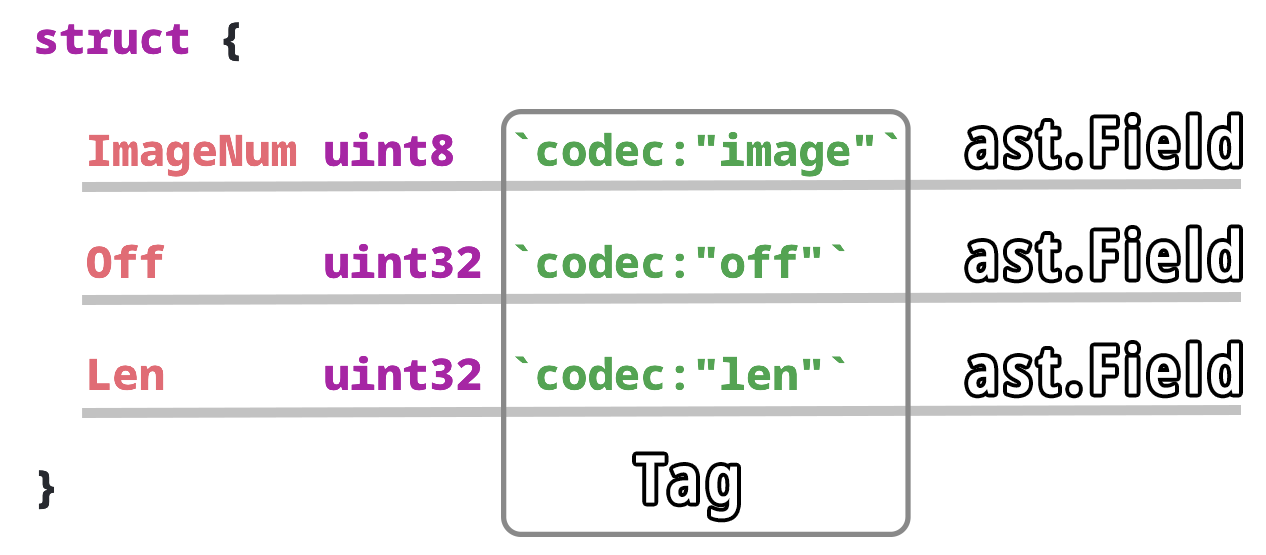
Finally we extract the CBOR Name from ast.Field.Tag and copy to DartField. But first let's understand what's inside Tag...
In the Go code that we're converting, we use the codec library to encode our Go Structs to CBOR. codec uses Field Tags like so...
struct {
Len uint32 `codec:"len"`
This tells codec to encode the field Len using the CBOR field name len.
So when we look at the CBOR output, we will see the field name encoded as len instead of Len.
codec Field Tags can have options...
struct {
Len uint32 `codec:"len,omitempty"`
This tells codec to skip the encoding of this field if it's empty.
Here's the code in our converter that takes a Field Tag like codec:"len,omitempty" and extracts the CBOR field name len: dart/convert.go
// Convert a Field Tag like `codec:"len,omitempty"`. CborName will be set to "len".
if astField.Tag != nil {
dartField.CborName = strings.Split(astField.Tag.Value, ",")[0]
dartField.CborName = strings.Replace(dartField.CborName, "codec:", "", 1)
dartField.CborName = strings.Replace(dartField.CborName, `"`, "", 2)
dartField.CborName = strings.Replace(dartField.CborName, "`", "", 2)
}
And we're done! After converting the Go Struct Field, we return the converted DartField...
// Convert a Go Struct Field astField to Dart
func convertField(fileset *token.FileSet, astField *ast.Field) DartField {
...
// Return the convert DartField
return dartField
}
That's how we auto convert a Go Struct Field to Dart with convertField()!
Now that we have convertField() to convert a single field of a Go Struct, let's convert an entire Go Struct...
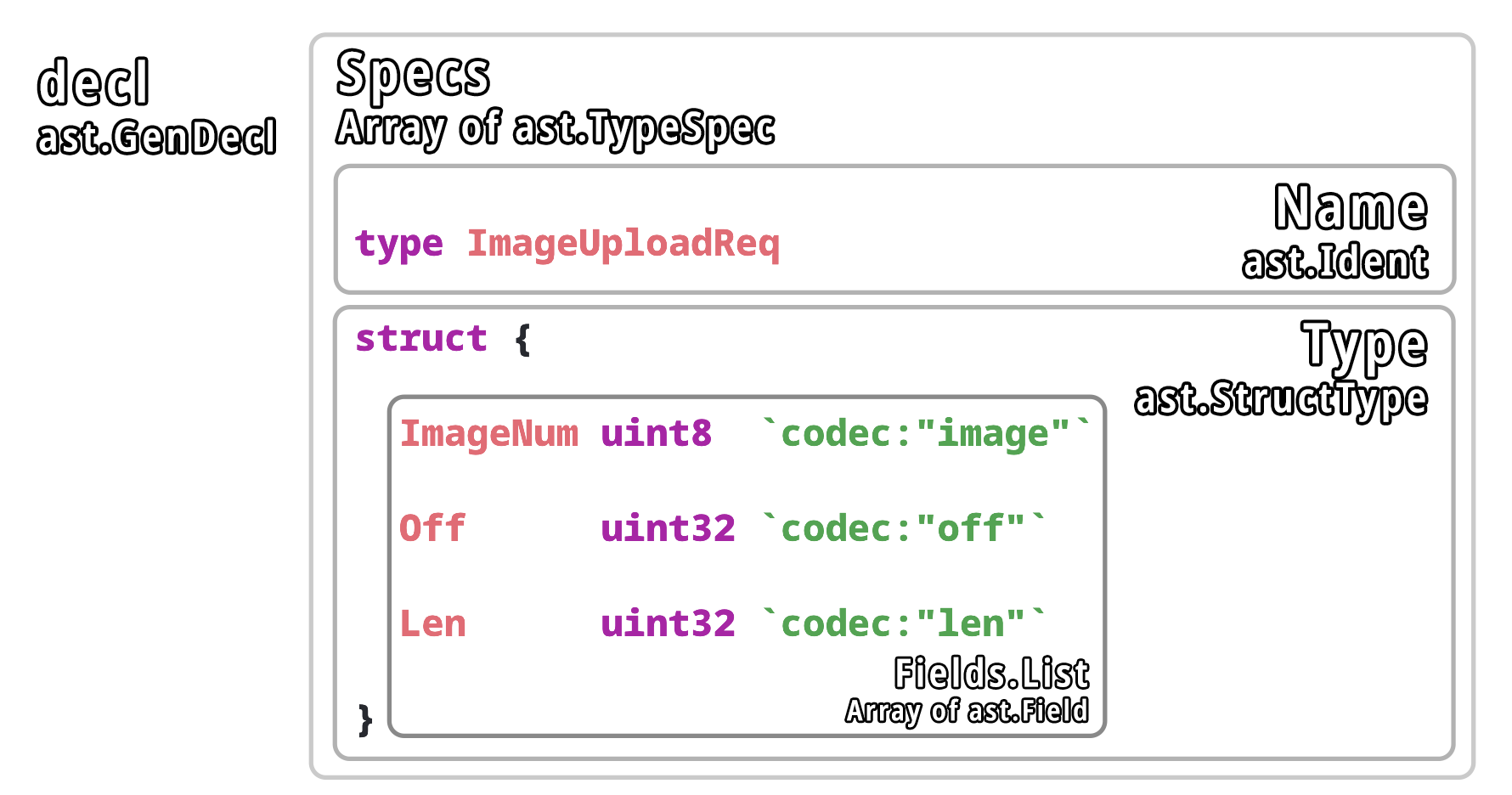
TODO
Here is the code that converts a Go Struct to Dart: dart/convert.go
// Convert Go Struct to Dart
func convertStruct(fileset *token.FileSet, decl *ast.GenDecl) {
// ast.Print(fileset, decl)
switch decl.Tok.String() {
case "type":
// Convert a type declaration
for _, spec := range decl.Specs {
switch spec := spec.(type) {
case *ast.TypeSpec:
// Get the struct name and output the Dart class
typeName := spec.Name.Name // "NmpHdr"
fmt.Printf("class %s ", typeName)
// If this is a request message struct...
if strings.HasSuffix(typeName, "Req") {
// Add the Dart mixin and interface classes
fmt.Println("")
fmt.Println(" with NmpBase // Get and set SMP Message Header")
fmt.Println(" implements NmpReq // SMP Request Message")
}
fmt.Println("{")
switch structType := spec.Type.(type) {
case *ast.StructType: // "struct {"
// Convert the struct fields
fields := structType.Fields.List
convertFields(fileset, fields)
fmt.Println("")
// If this is a request message struct...
if strings.HasSuffix(typeName, "Req") {
fmt.Println(" NmpMsg Msg() { return MsgFromReq(this); }\n")
// Generate CBOR encoder
generateCborEncoder(fileset, fields)
}
Code conversion is fuzzy and somewhat unreliable, so we always put checks to ensure that we are interpreting the code correctly...
default:
fmt.Println("*** Unknown Spec Type:")
ast.Print(fileset, spec.Type)
}
default:
fmt.Println("*** Unknown Spec:")
ast.Print(fileset, spec)
}
}
fmt.Println("}\n")
default:
fmt.Println("*** Unknown Tok:")
ast.Print(fileset, decl.Tok)
}
}
// Convert Go Struct Fields to Dart
func convertFields(fileset *token.FileSet, astFields []*ast.Field) {
for _, field := range astFields {
// ast.Print(fileset, field)
dartField := convertField(fileset, field)
if dartField.Name != "" {
fmt.Printf(" %s %s;\t// %s: %s\n", dartField.DartType, dartField.Name, dartField.CborName, dartField.GoType)
}
}
}
// Convert From Go...
// Go Struct
type ImageUploadReq struct {
NmpBase `codec:"-"`
ImageNum uint8 `codec:"image"`
Off uint32 `codec:"off"`
Len uint32 `codec:"len,omitempty"`
DataSha []byte `codec:"sha,omitempty"`
Upgrade bool `codec:"upgrade,omitempty"`
Data []byte `codec:"data"`
}
// Converted To Dart...
// Converted Dart Class
class ImageUploadReq
with NmpBase // Get and set SMP Message Header
implements NmpReq // SMP Request Message
{
int ImageNum; // image: uint8
int Off; // off: uint32
int Len; // len: uint32
typed.Uint8Buffer DataSha; // sha: []byte
bool Upgrade; // upgrade: bool
typed.Uint8Buffer Data; // data: []byte
NmpMsg Msg() { return MsgFromReq(this); }
/// Encode the SMP Request fields to CBOR
void Encode(cbor.MapBuilder builder) {
// ...Omitted...
}
}
TODO
// Convert From Go...
// Go Struct
type ImageUploadReq struct {
NmpBase `codec:"-"`
ImageNum uint8 `codec:"image"`
Off uint32 `codec:"off"`
Len uint32 `codec:"len,omitempty"`
DataSha []byte `codec:"sha,omitempty"`
Upgrade bool `codec:"upgrade,omitempty"`
Data []byte `codec:"data"`
}
// Converted To Dart...
// Converted Dart Class
class ImageUploadReq
with NmpBase // Get and set SMP Message Header
implements NmpReq // SMP Request Message
{
...
/// Encode the SMP Request fields to CBOR
void Encode(cbor.MapBuilder builder) {
builder.writeString("image");
builder.writeInt(ImageNum); // uint8
builder.writeString("off");
builder.writeInt(Off); // uint32
builder.writeString("len");
builder.writeInt(Len); // uint32
builder.writeString("sha");
builder.writeArray(DataSha);// []byte
builder.writeString("upgrade");
builder.writeBool(Upgrade); // bool
builder.writeString("data");
builder.writeArray(Data); // []byte
}
}
Here is the code that generates the CBOR Encoder for a Go Struct: dart/convert.go
// Generate the Dart CBOR Encoder function for the Go Struct Fields
func generateCborEncoder(fileset *token.FileSet, astFields []*ast.Field) {
fmt.Println(" /// Encode the SMP Request fields to CBOR")
fmt.Println(" void Encode(cbor.MapBuilder builder) {")
for _, field := range astFields {
// ast.Print(fileset, field)
dartField := convertField(fileset, field)
if dartField.CborName != "-" { // Fields tagged `codec:"-"` will not be ended
// Encode the string key
fmt.Printf(" builder.writeString(\"%s\");\n", dartField.CborName)
// Encode the value
fmt.Printf(" builder.write%s(%s);\t// %s\n", dartField.CborType, dartField.Name, dartField.GoType)
}
}
fmt.Println(" }")
}
TODO
// Convert From Go...
// Go Function
func NewImageUploadReq() *ImageUploadReq {
r := &ImageUploadReq{}
fillNmpReq(r, NMP_OP_WRITE, NMP_GROUP_IMAGE, NMP_ID_IMAGE_UPLOAD)
return r
}
// Converted To Dart...
// Converted Dart Function
ImageUploadReq NewImageUploadReq() {
var r = ImageUploadReq();
fillNmpReq(r, NMP_OP_WRITE, NMP_GROUP_IMAGE, NMP_ID_IMAGE_UPLOAD);
return r;
}
Here is the code that converts a Go function to Dart: dart/convert.go
// Convert Go Function to Dart
func convertFunction(fileset *token.FileSet, decl *ast.FuncDecl) {
// ast.Print(fileset, decl)
name := decl.Name // Function Name: "NewImageUploadReq"
returnType := fmt.Sprintf("%v", decl.Type.Results.List[0].Type) // Return Type: "&{40 ImageUploadReq}"
// Convert the return type "&{40 ImageUploadReq}" to "ImageUploadReq"
if strings.HasPrefix(returnType, "&{") && strings.HasSuffix(returnType, "}") {
returnType = strings.Split(returnType, " ")[1]
returnType = strings.Replace(returnType, "}", "", 1)
}
// TODO: Convert function parameters
// Output function declaration
fmt.Printf("%s %s() {\n", returnType, name)
// Convert the statements in the body
body := decl.Body.List
for _, stmt := range body {
// ast.Print(fileset, stmt)
// Convert the statement to a string
var buf bytes.Buffer
if err := format.Node(&buf, fileset, stmt); err != nil {
panic(err)
}
dartStmt := fmt.Sprintf("%s", buf.Bytes()) // "r := &ImageUploadReq{}"
// Convert specific kinds of statements
switch stmt.(type) {
case *ast.AssignStmt:
// For Assignment Statement "r := &ImageUploadReq{}", rewrite to "var r = ImageUploadReq()"
dartStmt = strings.Replace(dartStmt, ":=", "=", 1)
dartStmt = strings.Replace(dartStmt, "&", "", 1)
dartStmt = strings.Replace(dartStmt, "{}", "()", 1)
dartStmt = "var " + dartStmt
}
// Terminate every statement with semicolon
fmt.Printf(" %s;\n", dartStmt)
}
// End of function
fmt.Println("}\n")
}
TODO
> Executing task: /usr/local/go/bin/go run dart/convert.go <
// Go Code...
package main
type ImageUploadReq struct {
NmpBase `codec:"-"`
ImageNum uint8 `codec:"image"`
Off uint32 `codec:"off"`
Len uint32 `codec:"len,omitempty"`
DataSha []byte `codec:"sha,omitempty"`
Upgrade bool `codec:"upgrade,omitempty"`
Data []byte `codec:"data"`
}
func NewImageUploadReq() *ImageUploadReq {
r := &ImageUploadReq{}
fillNmpReq(r, NMP_OP_WRITE, NMP_GROUP_IMAGE, NMP_ID_IMAGE_UPLOAD)
return r
}
// Converted To Dart...
class ImageUploadReq
with NmpBase // Get and set SMP Message Header
implements NmpReq // SMP Request Message
{
int ImageNum; // image: uint8
int Off; // off: uint32
int Len; // len: uint32
typed.Uint8Buffer DataSha; // sha: []byte
bool Upgrade; // upgrade: bool
typed.Uint8Buffer Data; // data: []byte
NmpMsg Msg() { return MsgFromReq(this); }
/// Encode the SMP Request fields to CBOR
void Encode(cbor.MapBuilder builder) {
builder.writeString("image");
builder.writeInt(ImageNum); // uint8
builder.writeString("off");
builder.writeInt(Off); // uint32
builder.writeString("len");
builder.writeInt(Len); // uint32
builder.writeString("sha");
builder.writeArray(DataSha); // []byte
builder.writeString("upgrade");
builder.writeBool(Upgrade); // bool
builder.writeString("data");
builder.writeArray(Data); // []byte
}
}
ImageUploadReq NewImageUploadReq() {
var r = ImageUploadReq();
fillNmpReq(r, NMP_OP_WRITE, NMP_GROUP_IMAGE, NMP_ID_IMAGE_UPLOAD);
return r;
}
TODO
Both languages were created at Google, yet so different
Minimise errors in conversion
Huge volume of code
Consistency of conversion
Easy cross reference
TODO
The code in this article is part of the upcoming open source PineTime Companion App for Android and iOS. So that we can update the firmware on our PineTime Smart Watches wirelessly, sync the date and time, show notifications from our phone, chart our heart rate, ... Maybe even control our smart home gadgets!
We'll be doing lots more coding...
Handle Other PineTime Commands: Update firmware, sync date and time, show mobile notifications, control smart home gadgets (via IFTTT and MQTT), ...
We shall do this by taking the Newt Manager code in Go and converting it to Flutter and Dart, as explained here...
Companion App for Linux Phones (like PinePhone): We shall take the Newt Manager code in Go and wrap it into a GTK3 app, using the gotk3 library...
PineTime Firmware Support: Today our PineTime Companion App talks to Mynewt and Zephyr operating systems on PineTime. We hope to implement the same Bluetooth LE protocol (Simple Management Protocol) on other operating systems, so that they may also enjoy wireless firmware updates...
"Firmware Update over Bluetooth Low Energy on PineTime Smart Watch"
Why are we maintaining two code bases: Flutter (for Android and iOS) and Go (for Linux phones)?
Because Flutter is probably the best way to build mobile apps... But it's not officially supported for Linux phones. The flutter_blue plugin doesn't support Linux either.
So we need to stick with Go for Linux phones.
We're now exploring go-flutter for porting the Flutter App to Linux. And recode flutter_blue via FFI to a Linux Bluetooth LE library (in Go or C).
(Maybe someday when Flutter is officially supported on Linux phones, we can scrap the Go version!)
If you're keen to help out with the PineTime Companion App (or anything else in PineTime), come chat with the PineTime FOSS Community (and me) in the PineTime Chatroom!
PineTime Chatroom on Matrix / Discord / Telegram / IRC
"Flutter State Management with Bloc for PineTime Companion App"
"Convert Go to Flutter and Dart for PineTime Companion App"
"Your First Bluetooth Low Energy App with Flutter"
"Your First GTK App with Go and VSCodium"
"MCUBoot Bootloader for PineTime Smart Watch (nRF52)"
"Firmware Update over Bluetooth Low Energy on PineTime Smart Watch"
"Wireless Firmware Update In Action on PineTime Smart Watch (nRF52)"
Got a question, comment or suggestion? Create an Issue or submit a Pull Request here...